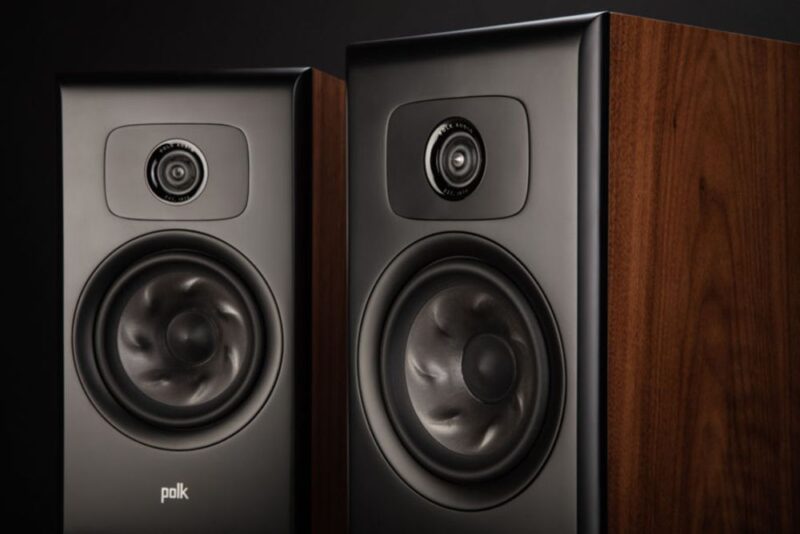I’ve told this story a couple of times before, but back at RMAF 2019, I was fortunate to be at the premiere of Polk Audio’s Legend Series, their new flagship speaker line. For Polk, the Legend line marked a return of sorts to high-end audio, and they made a huge splash with their new SDA floorstander, the $6000 L800.
While most people ogled at the impressive towers in the main room, I spied some folks peeling off to an adjoining room in the back of the suite, and I followed. In that room was a demo of the smallest speaker in the Legend series, the $1199 LEGEND L100 bookshelf, matched up with a DENON PMA-1600NE integrated. I was so impressed with what I heard, I requested the same combo to listen to at my home.
Well, I also dug the combo at my house and wrote a rave review.
That’s why when I was offered to check out the $1799 Polk Audio LEGEND L200 Bookshelf, the bigger brother to the L100 (6.5” midbass woofer compared to 5.25”), I jumped at the chance. I was interested to know how a Legend standmounter would sound with a little more bottom end energy, and I was not disappointed.
Disclaimer: The LEGEND L200 was sent to us in exchange for an honest review, no external input was given regarding the content of this review.
In the past, when I’ve moved up in a particular speaker line from a smaller standmount model to a larger version, it hasn’t always been great. I found that sometimes the speaker’s design didn’t scale well, and as you moved up in size, the tonal balance was thrown off.

That is not the case with the L200. In this case, Polk has masterfully scaled up the warm, natural sound I heard in the L100, making for a thoroughly insightful and exciting listen, provided you have the proper amplification. You also need to be careful with placement as the L200’s are very sensitive when it comes to positioning. I found a slight change in toe-in can totally change the sound characteristics.
However, it’s not that difficult to get the placement right. All you have to do is follow the instructions in the manual. Polk suggests that you point these speakers directly at the listening position, and based on my experience, that will give you the best sound from these babies.
Once you have them set up and dialed in, the L200 will grace you with some of the most natural midrange and highs I have heard at their price point. Jazz and Acoustic performances (especially live recordings) have that realistic “you are there” quality that I love in the B&W 700 Series (which costs almost double).
The only thing to look out for on the sound front would be slight port noise when playing songs with a busy bottom end. It’s there, but not super noticeable, so my mention is probably more nitpicking than anything else.
I think the LEGEND L200 speaker is an excellent option if you want the palpable, natural, midrange of British monitors like Harbeth, ProAc, or Bowers & Wilkins at a lower price point. If you want more detail on how I came to this conclusion, read on!

Build/Features:
Since the LEGEND L200 is basically a larger version of the L100 standmount speaker I reviewed previously, I won’t go into too much detail regarding all the technology; you can read that review for more in-depth descriptions. But the gist of it is, the L200 is a 2-Way, rear-ported design with a 1” ring radiator tweeter and 6 ½” Turbine Cone created especially for the LEGEND series.
The Turbine Cone is made of a light foam core material with a molded spiral pattern (called Turbine Geometry) for enhanced damping. According to Polk, this allows for a more natural midrange and controlled bass, and I would say it definitely works in this model.
The 1” ring radiator tweeter is a refinement of a design Polk has used on past flagship models, the new version distinguished by its pointy phase plug in the center. Along with the signature Phase plug, this latest version incorporates a special weave material along with a damped back chamber to cut down on distortion and keep the top end sweet. I would say this arrangement also works as advertised.
The tweeter is ensconced in a very shallow waveguide, which is said to widen the sweet spot, but I didn’t find the sweet spot to be extraordinarily wide from my experience. But after hearing what this speaker can do, it’s not the end of the world.

As far as the cabinet is concerned, Polk conveys this speaker’s premium standing with real wood veneer on the outside of the substantial real-wood cabinet, along with heavy-duty dual bi-wire, bi-amp capable 5-way binding posts. The speakers are on the large side (8-3/8″W x 15-11/16″H x 13-5/16″D) but not much bigger than other speakers with a 6 ½ midbass driver.
You also get magnetic grilles, which keep the front baffle clean. Polk says the grilles are acoustically inert, which is good if you want to hide the drivers without affecting the sound. They come in two colors, Brown Walnut and Black Ash.
The L200 also has the latest edition of the Power Port, a device they have used since I sold Polk in the 90s. Power Port technology places a cone in front of the port to evenly disperse turbulence coming from the speaker, which cuts down on port noise and cleans up the bass. It’s also supposed to increase the bass output by stabilizing the airflow coming out of the port.

Listening to the Polk Audio LEGEND L200 Bookshelf Speaker
I set up the LEGEND L200s about three feet from the sidewalls and about four feet out from the front wall for my listening tests. This is further out into the room than I usually place speakers, but I felt this was necessary to keep these powerful speakers from coupling to the room.
The speakers were about seven feet from the listening position and about eight feet apart. As I said earlier, I pointed them directly at the listening position, which gave me the best imaging and soundstage. I tried toeing them out a smidge for an even wider soundstage, but it killed the focus, so I promptly put them back where I had them. Also, as I said earlier, you must provide the proper amplification for these speakers. With a sensitivity rating of 85.5 dB (which is on the low side) plus a 4-ohm impedance (which can drop to 3 ohms), you need an amp with decent power and high current, or the bass will be plodding and flabby. This throws the rhythm totally off, ruining the whole presentation.
Because of this, I tried no less than six different amps with the L200s before I was totally satisfied with the performance. At the end of the day, I found three of them that matched up well in terms of price (meaning they were priced in line with the speakers) and driveability.

To me, the three in order of favorability (based on personal preference) were the Parasound NewClassic 200 Integrated ($1195) in first place, the Cambridge Audio CXA81 Integrated ($1299) in second place, and the Denon PMA-1600NE Integrated ($1599) in third.
The Parasound (The only Class D amp of the bunch for those who care) provided the best combination of transparency and control, followed by the CXA81, which had the best bass control (actually added a little excitement to the mix with its deep bass) but wasn’t quite as transparent as the NewClassic 200. The PMA-1600NE was basically middle of the road on both transparency and control compared to the others, and since it’s the least edgy of the group, it will probably make those like a more laid back presentation happy.
But in my case, the Parasound/Polk just clicked and put me in a great place. Listening to “John Henry” by Cecile McLorin Salvant, I was entranced by the nice weight of the Double Bass on the intro, followed by the palpable rendition of McLorin Salvant belting out the rapid-fire lyrics. When the piano came in, the fast solo also sounded extraordinarily natural.
Listening to “Teach You” from Emily King’s album “Sides,” the Legend L200 put on an imaging and soundstage tour de force. This song is a harmonious duet sung by King alongside award-winning vocalist Sara Bareilles. On a good system, you can actually hear them singing alongside each other in the middle of the stage.
The Polk’s rendition of their interplay on the song was magical, as was the placement of the backing piano and drums off to both sides of the singers, spread across the room. Separation is superb. The scale in my average-sized room (15 x 18) was also very nice. You can probably get nice results with these speakers in even larger spaces.
If I had any complaint about the sound, it would be some slight port noise during busy, bass-heavy passages, which, as I said earlier, is mostly a nitpick on my part since it’s not very distracting. There is also a sub-bass roll-off, which is pretty much part and parcel of a bookshelf speaker. Just get a sub.

Compared to the KEF LS50 (Original, Non-Meta)
I compared the L100 to the Kef LS50 (the original, non-meta version) just like I did the smaller L100, and while I thought the choice between the L100 and LS50 was a matter of preference, I found the L200 bested them in every way. The L200 dug deeper, had better dynamics, and was more transparent. If anything, the upper bass was a little more articulate on the LS50 but not enough to make me pick them over the L200.
The Wrap Up
 The Polk Audio Legend L200 just wowed me when it came to soundstage, imaging, sweet highs, good bass weight, and beautiful, natural-sounding midrange. If you are hooked on a liquid midrange, then you need to give these speakers a shot. Just be aware, these speakers are very demanding when it comes to amplification. However, if you take the time to match them well (I highly suggest the Parasound NewClassic 200 Integrated) and dial in the positioning, you will be greatly rewarded.
The Polk Audio Legend L200 just wowed me when it came to soundstage, imaging, sweet highs, good bass weight, and beautiful, natural-sounding midrange. If you are hooked on a liquid midrange, then you need to give these speakers a shot. Just be aware, these speakers are very demanding when it comes to amplification. However, if you take the time to match them well (I highly suggest the Parasound NewClassic 200 Integrated) and dial in the positioning, you will be greatly rewarded.
As an Amazon Associate, Hifitrends.com may earn from qualifying purchases via links placed throughout the site…this helps us keep the website going! Thanks in advance for your help! Prices are subject to change at any time.

I’m an audio writer who started as a young audio salesman/consumer electronics professional back in the late 90s. That’s where I discovered the magic of 2-Channel sound. My thirst for great sound has led me on a delightful music quest that continues today.



Leave a Reply